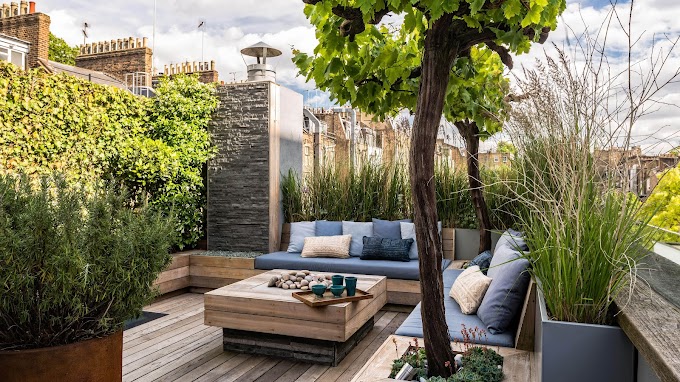Delhi, the capital of our country, is probably one of the places with the most historical monuments. It has many tombs, forts and other architectural marvels spread across the city which give it a beautiful charm. From red brick buildings to stone buildings and from pillars to ghats, Delhi is a wonderful place to explore India's rich history. We bring you some such monuments that you must visit on your next trip to the capital.
Amazing Architectural Buildings in Delhi
Humayun’s Tomb
It was the first garden-tomb of its kind in India which
reflects the Mughal style of architecture. The tomb was built in the memory of
Humayun in 1569 by his widow Banu Begum. Showcasing a true Mughal architecture
with its garden squares, water canals along the paths and a double domed
mausoleum situated in the center of the Charbagh, it is also known as the 'Mini
Taj'. Very few people know that the Taj Mahal was modelled after Humayun's Tomb,
and it is the design of Humayun's Tomb that inspired the layout and
architecture of the iconic 'Taj'.
Akshardham Temple
Acclaimed as the second largest Hindu temple in the world
after Akshardham Temple in Gandhinagar, Akshardham Temple in Delhi is a recent
addition to the architectural gems of India. The temple was inaugurated on 6
November 2005, and it took 5 years and the efforts of 11000 artisans for its large-scale
construction. Akshardham Temple in Delhi is a part of Bochasanwasi Shri Akshar
Purushottam Swaminarayan Sanstha or BAPS.
Made of pink stone and white marble, the Akshardham temple
structure has intricately carved pillars and domes decorated with stone
sculptures and sculptures depicting scenes from Indian mythology. The grand
beauty and grandeur of Akshardham Temple will leave you spellbound.
Lotus Temple
The Lotus Temple, also known as the Bahá'í Temple, was built
in 1986 to bring together different religious beliefs on a single platform. The
architecture of the temple depicts the shape of a half-open lotus flower. The
structure is made of pure white marble and has 3 sets of 9 lotus petals. Within
these petals is a meditation hall where followers of any religion can visit and
offer prayers.
Around the petals, you will see 9 pools of water which look
spectacular during the night when coloured lights fall on the water. The
architecture and design of the Lotus Temple is worthy of admiring the
architectural prowess of the Iranian Canadian architect, Fariburj Sahba, who
lauded its design.
Shri Ram Centre
Dubbed as one of the most famous theatres in Delhi for the
performing arts and one of the iconic structures; The seemingly unconventional
Shri Ram Center, built in the same year as the Akbar Hotel, are both historic
projects of AR. Shivnath Prasad.
The structure's unconventional, off-the-beat geometry
conveys the brutal nature with its bold massing. Its exposure is the beauty of
it!
Akbar Hotel
If Delhi is the political and administrative capital of
India, the 'Chanakyapuri neighbourhood', where this sprawling Akbar Hotel is
located, is Delhi's diplomatic enclave where you can find most of the foreign
embassies and even the prime minister's residence.
Heavy mass, with bold design form and straight lines set the
template for the brutalist movement's no-nonsense attitude. The Akbar Hotel is
a classic Brutalist building prototype.
Hall of Nations, Pragati Maidan
Sometimes death tells you the importance of life.
If this is true for us humans, it does the same amazing
architectural buildings in Gurgaon you must know!
on April 24, 2017; Delhi as well as India's architectural
community reacted in shock and rebellion to the news that the "Hall of
Nations" had been demolished. Possibly the world's first—and largest—span
space-frame structure built using reinforced concrete. The demolition faced
widespread condemnation and rebellion by architects and historians alike.
However, this led to a rebirth of love for Brutalist architecture. And as they
say, "sometimes, something happens for some reason".
NCDC Building
Some identify it with brutality, others remember it when
crossing the Madurai Meenakshi Temple, and 'Delhi's famous auto walas' know it
as the pajama building, because it shows the shape of the building. Two zig-zag
concrete wings reach the top, with a central aisle that links the wings and the
service core together.
“The building carries itself visually and structurally”,
says designer Kuldeep Singh.
Chanakya Cinema Hall
The iconic cinema house that used to be the heartthrob of
almost every youth of Delhi in the 1980s and 90s is no more!
The cinema hall proudly displayed its structural components
on its skin, with the exterior following the shape of the auditorium inside.
Today, 'Chanakya Mall' stands on the soil of a land filled with ruins of the
iconic cinema hall.
heart breaking right: Can't help it, the world isn't a fair
place anymore!
If you want to build & remodel your dream house or
office? Check out our refined list of architects in Noida and Delhi! Don't
forget to share this article with your family and friends.














0 Comments